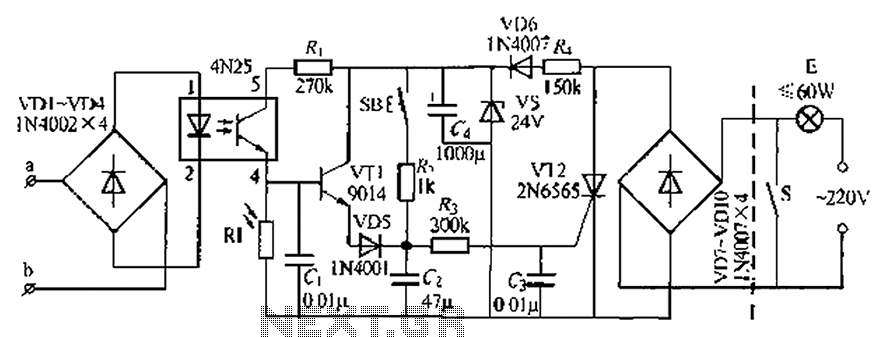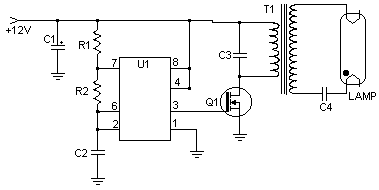
Three-Way Touch Lamp
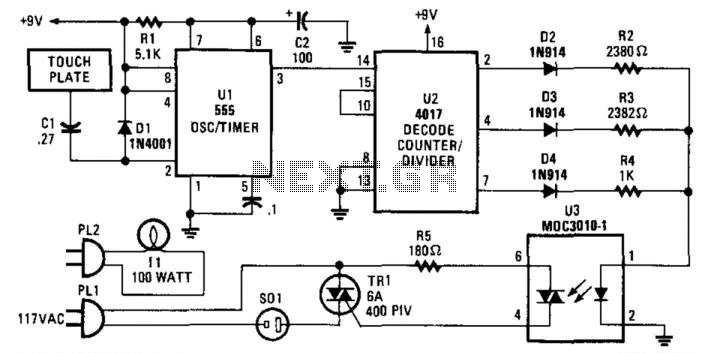
A three-way switch controls a lamp with off-dim-bright settings using an NE555 timer to generate a one-second pulse, triggered by ambient AC fields detected by the human body. CI and D1 form an input network. U2 is a decode counter/divider that drives one of 10 outputs (three of which are utilized). The logic outputs control various resistors in series with the LED in the optocoupler. The optocoupler manages a triac that is in series with the load (lamp, etc.). By reconfiguring the outputs of U2, it is possible to achieve more than three brightness levels, up to a maximum of 10. An IN914 diode and a resistor are required for each output.
The circuit design utilizes a three-way switch to manage the brightness of a lamp, providing options for off, dim, and bright settings. The NE555 timer serves as the core component for generating a one-second pulse, which is essential for the operation of the system. This pulse is triggered by ambient AC fields detected by the human body, allowing for a touch-sensitive control mechanism that enhances user interaction with the lamp.
The input network is composed of a capacitor (CI) and a diode (D1), which work together to filter and condition the incoming signals from the ambient fields. The decoded output of the NE555 timer is fed into a decode counter/divider (U2), which is capable of producing up to 10 distinct outputs. In this application, three of these outputs are utilized to control the brightness levels of the lamp.
The logic outputs from U2 are connected to various resistors that are placed in series with an LED in an optocoupler. The optocoupler serves as an interface between the low-voltage control signals and the higher voltage required to drive the lamp. The output from the optocoupler controls a triac, which acts as a switch for the lamp load. The triac allows for smooth control of the lamp's brightness by regulating the power delivered to it.
To expand the functionality of the circuit, the outputs from U2 can be reconfigured, enabling the achievement of up to 10 different brightness levels. This flexibility allows for a wide range of lighting conditions to suit various user preferences. Each output requires an IN914 diode and a resistor to ensure proper operation and signal integrity. Overall, this circuit design exemplifies an innovative approach to lighting control, utilizing modern electronic components to create a versatile and user-friendly lighting solution. A three-way switch to control a lamp (off-dim-bright, etc.) uses an NE555 timer to generate a one-second pulse, trigge red by ambient ac fields that are picked up by the human body. CI and D1 form an input network. U2 is a decode counter/divider and drives one of 10 outputs (three are used). The logic outputs drive various resistors in series with the LED in the optocoupler. The optocoupler controls a triac that is in series with a load (lamp, etc.). By reconfiguring the outputs of U2, more than three brightness levels can be obtained, up to 10. An IN914 and resistor will be required for each output. 🔗 External reference
The circuit design utilizes a three-way switch to manage the brightness of a lamp, providing options for off, dim, and bright settings. The NE555 timer serves as the core component for generating a one-second pulse, which is essential for the operation of the system. This pulse is triggered by ambient AC fields detected by the human body, allowing for a touch-sensitive control mechanism that enhances user interaction with the lamp.
The input network is composed of a capacitor (CI) and a diode (D1), which work together to filter and condition the incoming signals from the ambient fields. The decoded output of the NE555 timer is fed into a decode counter/divider (U2), which is capable of producing up to 10 distinct outputs. In this application, three of these outputs are utilized to control the brightness levels of the lamp.
The logic outputs from U2 are connected to various resistors that are placed in series with an LED in an optocoupler. The optocoupler serves as an interface between the low-voltage control signals and the higher voltage required to drive the lamp. The output from the optocoupler controls a triac, which acts as a switch for the lamp load. The triac allows for smooth control of the lamp's brightness by regulating the power delivered to it.
To expand the functionality of the circuit, the outputs from U2 can be reconfigured, enabling the achievement of up to 10 different brightness levels. This flexibility allows for a wide range of lighting conditions to suit various user preferences. Each output requires an IN914 diode and a resistor to ensure proper operation and signal integrity. Overall, this circuit design exemplifies an innovative approach to lighting control, utilizing modern electronic components to create a versatile and user-friendly lighting solution. A three-way switch to control a lamp (off-dim-bright, etc.) uses an NE555 timer to generate a one-second pulse, trigge red by ambient ac fields that are picked up by the human body. CI and D1 form an input network. U2 is a decode counter/divider and drives one of 10 outputs (three are used). The logic outputs drive various resistors in series with the LED in the optocoupler. The optocoupler controls a triac that is in series with a load (lamp, etc.). By reconfiguring the outputs of U2, more than three brightness levels can be obtained, up to 10. An IN914 and resistor will be required for each output. 🔗 External reference
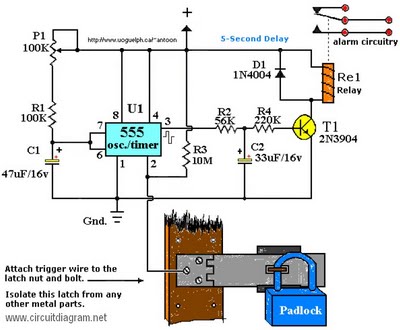
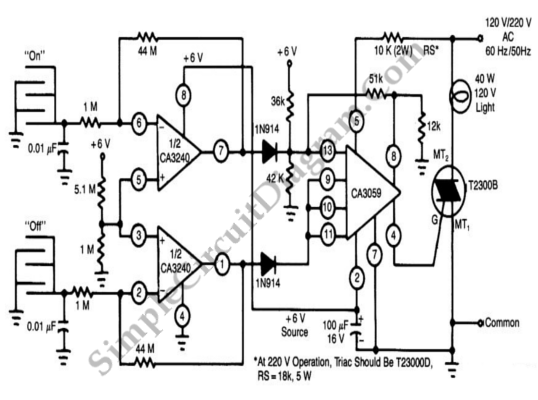
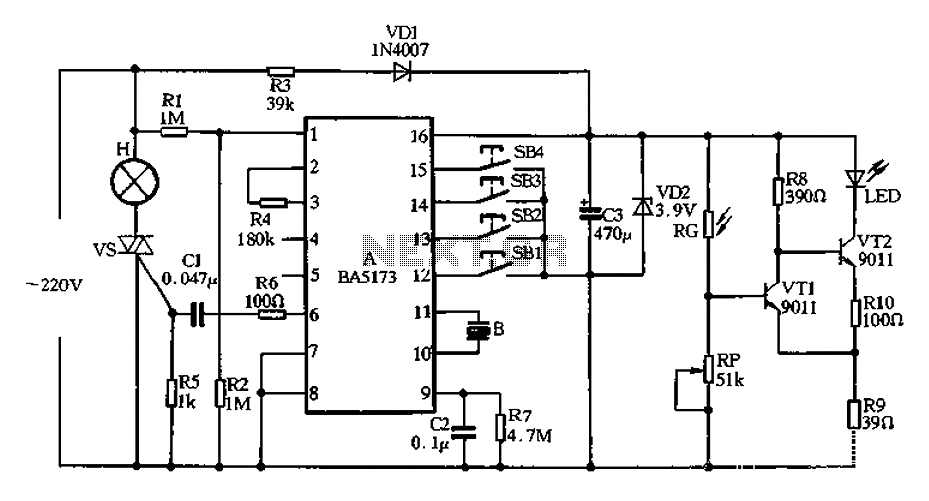
%2Band%2B(US)%2BCX500%2BC%2B1979-81%2Band%2B1979%2BCX500%2BD%2BElectrical%2BWiring%2BDiagram.jpg)
